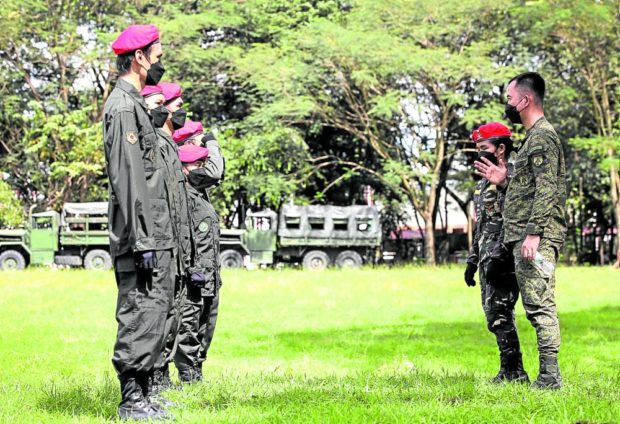Shortage of military trainers should not hinder mandatory ROTC – senators

ROTC BY A NEW NAME A bill requiring college students to undergo the National Citizens Service Training Service Program hurdled the House plenary on Wednesday. Those who finish the program will become reservists in the Armed Forces, according to the measure. —LYN RILLON
Updated @ 6:06 a.m., Jan. 26, 2023
MANILA, Philippines — A lack of military personnel to implement the Reserve Officers Training Corps (ROTC) program should not be taken as a hindrance to making the program mandatory, senators said on Wednesday.
Defense Undersecretary Franco Gacal told the Senate committee on higher, technical, and vocational education that 9,000 to 10,000 military personnel would be needed to staff the ROTC program for students enrolled in 2,400 higher education institutions (HEIs), not including those in the Technical Education and Skills Development Authority (Tesda) and out-of-school adolescents.
This estimate, he noted, is assuming four members of the military will be designated to each HEI to man the program.
“Can the armed forces do it? When we say this, we talk about manpower. We talk about financial resources and logistical facilities, etcetera. Because to run this program, the requirement is really enormous,” Gacal said in a mix of English and Filipino.
Sen. Ronald dela Rosa, who presided over the panel hearing, fumed over the sentiment as he insisted that he did not see “any impossibility” in reviving the mandatory ROTC since it had been done before.
“If this is the attitude of our defense department, then let’s stop this. Let’s just go back to the NSTP if that’s what you want,” he said.
Dela Rosa was referring to the National Service Training Program, which has three components–the ROTC, Civic Welfare Training Service and Literacy Training Service.
The NSTP is a requisite for graduating students enrolled in baccalaureate degree courses and in technical-vocational courses that last for at least two years.
Dela Rosa slammed the Department of National Defense (DND) for its seemingly “lukewarm” stance on the proposal to revive compulsory ROTC.
“You don’t want to carry the ROTC work on your shoulders. You want to share the task with others because you’re scared of the expenses. That’s why we’re making it a law, so the requirements will be covered by the law. But if you’re lukewarm in the defense department, like you’re having second thoughts then, let’s scrap this and revert back to NSTP,” he added.
Dela Rosa then asked again if the military could implement the return of the mandatory ROTC.
“The logistical and financial issues can be addressed by Congress support, but really, the main concern right now is about manpower,” Gacal answered.
Dela Rosa said that if lacking manpower is the DND’s concern, they can just recruit additional personnel. He also echoed a suggestion earlier made by General Marlou Salazar to tap reservists in the implementation of the ROTC program.
Senator Francis Tolentino further stressed that the lack of resources should not be seen as an obstacle in the revival of compulsory ROTC, citing how the Tarlac provincial government could recruit 5,000 personnel for the program.
“This proves that with a little nudge and perhaps, collaboration with the Department of the Interior and Local Government, this program will flourish. The 10,000-personnel requirement isn’t scary to think of when the Tarlac province alone was able to recruit 5,000,” he further argued.
Senator Sherwin Gatchalian instructed the DND to furnish the committee with a list of its “critical requirements” which, Gacal said, must be addressed should ROTC be made mandatory.
Vice President and concurrent Education Secretary Sara Duterte earlier expressed hopes that the mandatory ROTC program would be among the priority legislative agenda of the administration of President Ferdinand Marcos Jr.
During his first State of the Nation Address in July, Marcos pushed Congress to pass a law mandating the ROTC program for senior high school students.
The ROTC was made optional through the NSTP Act of 2001 following the brazen killing of University of Santo Tomas sophomore cadet Mark Welson Chua, who had exposed corruption in his school’s ROTC.